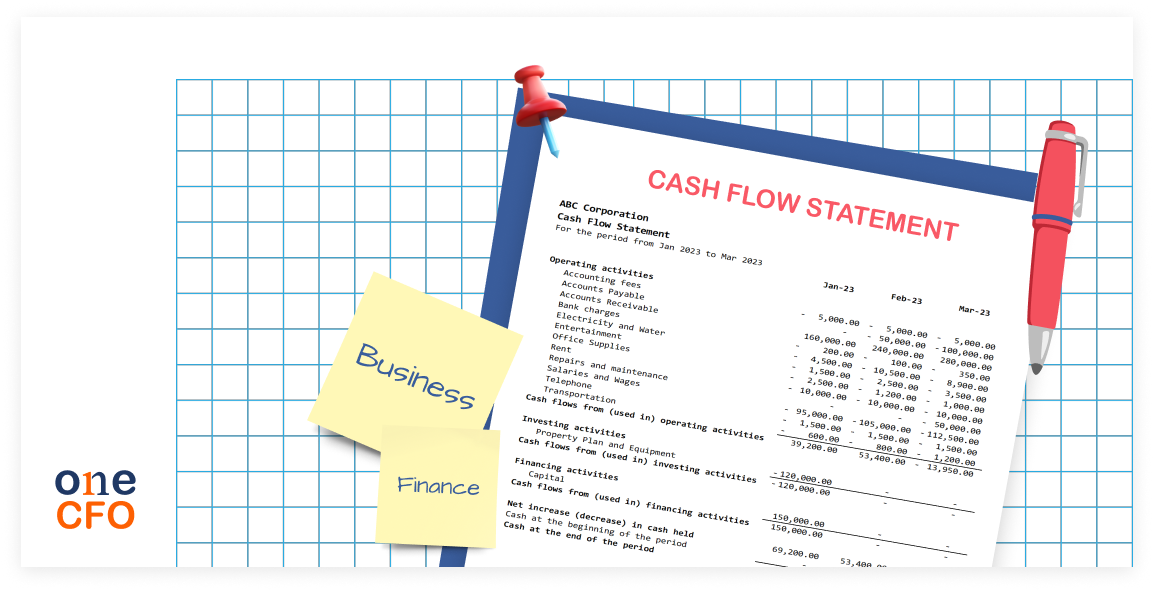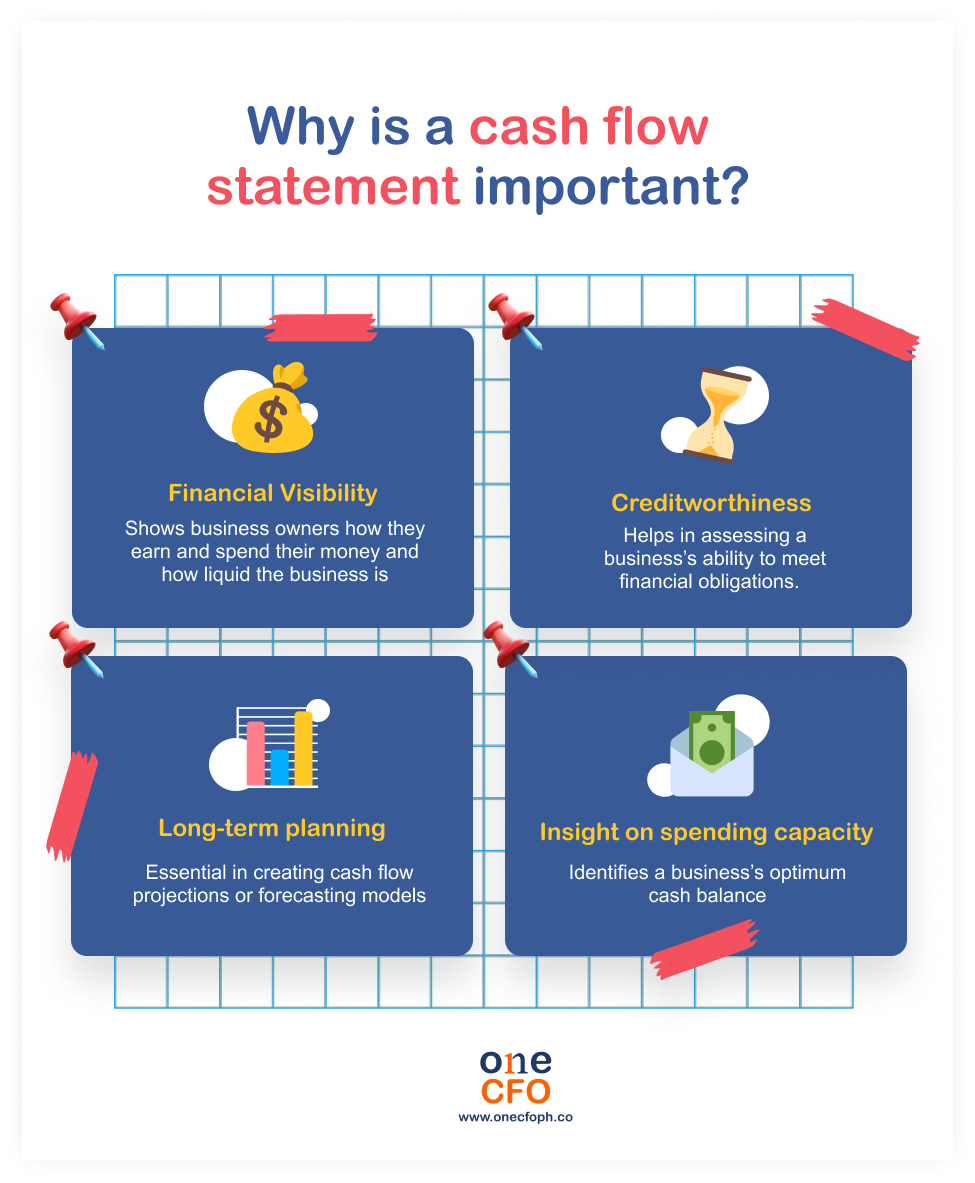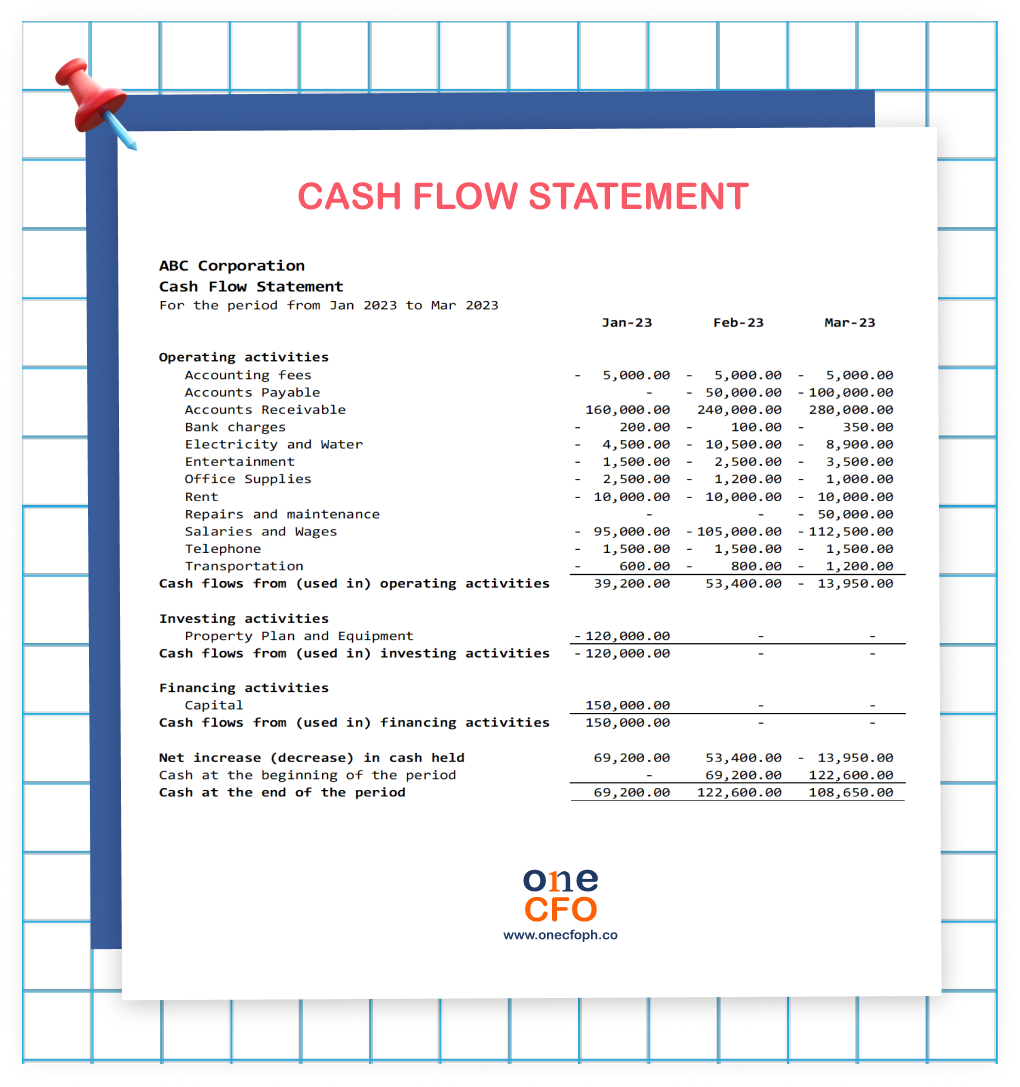
September 8, 2023 | 3:34 pm
Table of Contents
Small businesses need a cash flow statement to understand the flow of money going in and out
of the company, helping assess its financial health and stability. Thus, all small
businesses need to prepare this important financial statement.
The cash flow statement helps small business owners identify if they have extra cash to
settle their payables or reinvest in the business. It can also show entrepreneurs if they’re
short on money, allowing them to find solutions early on.
However, small businesses may need help and guidance in preparing the cash flow statement.
Cash flow data must be categorized into three important components - operating, investment,
and financing activities.
This guide will explain cash flow statements in-depth, including their importance,
components, and how to prepare this report.
What is a cash flow statement?
Before anything else, what is a cash flow statement?
A cash flow statement, or CFS, is a
financial document showing all incoming and outgoing
transactions in a certain period. Ultimately, this financial statement indicates the
liquidity of a business and your cash position or how
much cash there is as of the moment.
A common mistake among small business owners is solely focusing on profitability. While
profitability is good for the business, knowing your cash flow is equally important. If you
don’t track your cash flow, you might wake up one day unable to pay your suppliers or bills
even though your business is supposedly making money.
The information in the cash flow statement comes from the income statement and balance
sheet, which is why these three financial statements are crucial. With the CFS,
entrepreneurs can identify which parts of the business generate and spend money and exactly
how much.
Why is a cash flow statement important?
Preparing a cash flow statement is essential for any small business and is an important step in a proper cash flow management system. With vital financial information on the flow of money in and out of the business, entrepreneurs make better short and long-term decisions.

What are the components of a cash flow statement?
The cash flow statement reflects how money or cash moves in and out of the business. This financial document divides your cash activities into three components or activities: operating, investing, and financing.
Example of a cash flow statement

Operating
All transactions related to regular business activities or the core of the business are part
of the operating component. These transactions are those needed to continue operations or
provide services and goods.
When organizing the cash flow activities in the operating component, the starting point
should be the net income after expenses. From here, the bookkeeper or accountant lists all
operating transactions and adds or subtracts these from the starting amount.
Ideally, the total cash flow from operating activities should always be positive. A negative
operating cash flow can mean spending too much on inventory, having more employees than you
can pay for, racking up expensive bills, or not making enough sales.
You can bridge a negative operating cash flow by getting funding from loans or investors or
selling your assets; however, always resorting to this solution won’t be sustainable in the
long run.
Most expenses listed in the operating component are deductions you can use for income
tax.
Here are some examples of transactions to include in this component:
Investing
The investing component of a CFS includes financial transactions related to buying and
selling fixed or long-term assets and investments. Entrepreneurs purchase these investments
for the company’s growth and expansion or sell assets to maintain the business’s operations.
For small businesses, the investing portion of their CFS might not be a lot. However, it’s
still important to note these transactions since they affect the working capital.
A business may have a negative investing cash flow after purchasing new properties or
equipment, but it's an investment for the business's benefit and long-term growth.
Some examples of transactions included in the investing component are:
Financing
The third section or component of a CFS includes all transactions involving financing the
company through owners, creditors, or investors. Financing can consist of acquiring business
loans from banks, funds raised from investors, paying dividends, or money given or taken out
by the owners.
The items included in the financing section can be as follows:
How to prepare a cash flow statement?
In preparing a cash flow statement, small business owners should understand how a CFS complements their income statement and balance sheet. There is also a need to choose what method to use when accounting for cash transactions.
How does the cash flow statement relate to the income statement and balance sheet?
Cash flow statement, income statement, and balance sheet are the most important financial
documents a business can have. Even though these three show different aspects of the
company, they are linked together.
As mentioned, the cash flow statement shows how cash moves in and out of the business. It
starts with using the net income from the income statement, which shows a company's revenue,
expenses, and profitability.
Meanwhile, a balance sheet indicates changes in
assets, liabilities, and shareholder's
equity. This document starts with the cash balance shown in the CFS and shows how the
company divides this balance between different components.
It's also best to remember that cash flow statements and other financial documents are only
as accurate as your bookkeeping. Knowing how to employ the best bookkeeping practices
ensures you have the correct information when preparing the CFS.
What are the two cash flow calculation methods?
There are two methods for calculating operating cash flow: the direct method and the indirect method.
Direct method
The direct approach is recommended for cash flow
calculations using the cash basis accounting. Cash basis
accounting only records financial activities once the company
receives or spends the money.
In the direct method, the bookkeeper records all cash transactions during the period.
Although it’s more straightforward, it can also be time-consuming since you need to track
the cash and receipts of every transaction.
Indirect method
On the other hand, the indirect method of preparing a cash
flow statement uses accrual-based
accounting data as a starting point. Accrual basis accounting records income even if a
customer has not paid yet and the expense even when you haven’t settled the bill.
In the indirect method, you start with the net income and then adjust for non-cash items and
changes in the working capital to arrive at the cash flow from operating activities.
For example, suppose you add revenue to the income statement, but the business hasn’t
received the money yet. Deduct the same revenue amount from the net income to reflect that
no cash came in the cash flow statement.
Another example is when a business deducts depreciation when computing the net income in the
income statement. The depreciation amount is then added to the cash flow statement to
indicate that no cash went out.
The indirect method may seem more complicated. However, it’s the more common approach.
Backtracking transactions or accruals from the income statement is easier and takes less
time to prepare, which is why it’s more suitable for small businesses.
What does positive and negative cash flow mean?
After listing all cash transactions in the cash flow statement, you can compute your overall net cash flow, either positive or negative. What does each of these mean?
Positive cash flow
There is a positive cash flow if more money goes into the business than out. A positive cash
flow is ideal for businesses; however, this is not enough to indicate good business
performance.
A business with a positive cash flow doesn’t automatically mean it’s profitable - it could
have raised funds from investors, increasing its incoming cash flow. It’s also possible for
a business to have a positive cash flow if they take out large business loans. However, they
must also prove they can pay the borrowing through revenue generation.
Positive cash flow can also mean the business has excess cash on hand, which it can use to
expand operations or reinvest for business growth.
Negative cash flow
On the contrary, spending more money than what your business earned results in a negative
cash flow.
A negative cash flow sometimes happens among startups as they usually aim for fast growth to
attract venture capital funding. They spend much capital on
improving their product or
increasing market share.
Some businesses may also get a negative cash flow, especially after investing huge amounts
of money for future growth. So, a negative cash flow isn’t an indicator of poor business
performance.
However, negative cash flow for extended periods can also be a red flag and show signs of
unsustainability. If this happens, the business owner should have a concrete plan to keep
operating and turn their cash flow positive sooner than later.
Need help in preparing and interpreting cash flow statements?
Creating an accurate cash flow statement is a way to keep your business financially healthy.
On top of this, business owners should also learn how to correctly interpret these
statements so they can take the right business actions.
If you need help keeping your financial data in order or need expert advice on managing
your business financially, OneCFO is here!
OneCFO is your outsourced finance department, providing reliable and tech-enabled payroll,
bookkeeping, tax compliance, and CFO services. As your partner, OneCFO provides the
financial management support you need so you can focus on growing and managing the business.
Visit us at onecfoph.co or contact us at [email protected] to
learn how we can help you
prepare and understand your cash flow statements and financial operations to propel business
growth.
Read our disclaimer here.